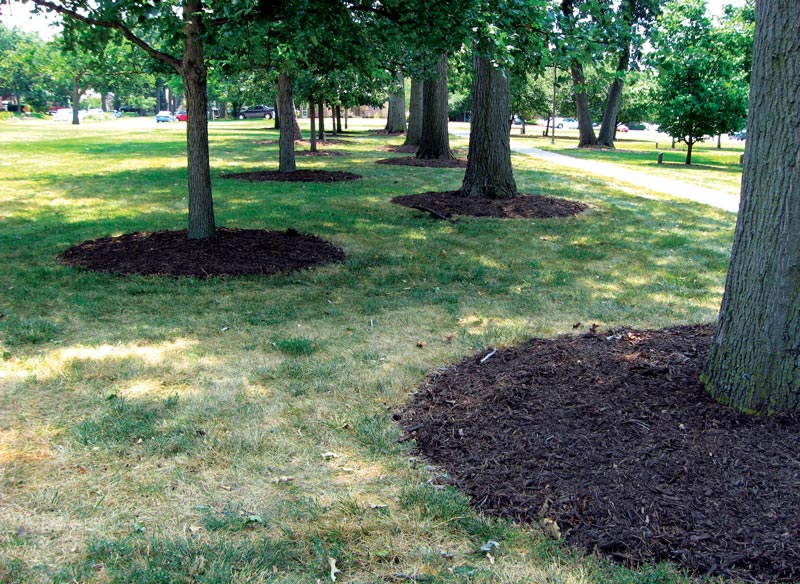
Natural wood-based mulch should be placed around trees, shrubs, ground covers and perennials as far into the golfscape as play will allow. Photos by John C. Fech
Human nature is a funny thing. We’re all familiar with the concept of “you get what you pay for,” but equally accurate is the notion that “you value what you pay for.” The second phrase is true of barbecue grills, fishing trips, televisions, sports cars and paintings. When you have a significant investment in a piece of property or positive experience, it tends to be of high importance in your life.
Prevention may not be perceived as all that powerful or valuable. After all, it’s not blasting out of the end of a hose like a fungicide or fertilizer. In most cases, it doesn’t require the outlay of a large amount of cash. To wield the power of prevention, people must think with their heads, not their hearts.
At the core of the power of prevention is the tried-and-true tenet that it’s usually much cheaper and less intrusive to fix a potential problem before it becomes a real problem down the road. When it comes to ornamentals on the golf course, there are lots of specific examples of preventing costly problems.
Planting time prevention
One of the most opportune times to prevent problems is at planting time. After all, once a tree, shrub or perennial is in the ground, the level of control a superintendent has over it goes way down. Considering the importance of the roots, both in terms of function as well as in size, it’s wise to pay attention to the root system as plants are installed.
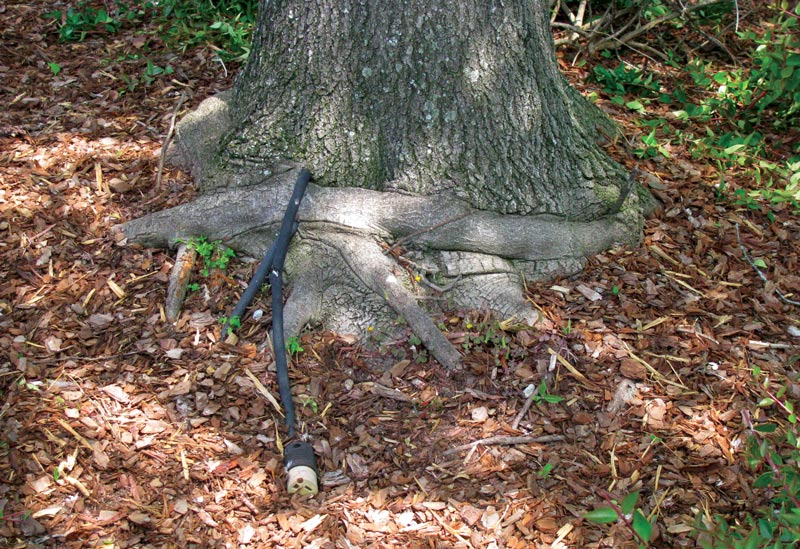
To avoid the development of unsightly and unhealthy girdled roots, gently loosen the tightly bound mass of encircled underground stems before planting.
The first issue is digging the proper-sized hole. Actually, it’s best to think of the excavated soil as a “planting area.” A good rule of thumb is to size up the root ball and create an opening in the ground no deeper than the root mass and three times as wide. A wide planting area helps encourage roots to expand rather than to remain where planted. In addition, placing the root ball on top of undisturbed soil in the planting area will prevent the root ball from sinking.
The next consideration is avoiding girdled roots. In many cases, trees arrive at the planting site in plastic pots or with the root ball — a mass of encircled underground stems — tightly bound with burlap. If left in this arrangement, the roots will continue to grow larger and larger in diameter, with very few breaking free of this pattern and outward into the adjacent soil. Those grown in nurseries using proprietary systems such as RootMaker, GroBag or RootTrapper technology tend to fare better, producing fewer girdling roots.
To the extent possible, break roots loose from the girdled root mass and spread them laterally in the planting hole. Inevitably, during this process, a few roots will break, exposing the inner tissues. As with many other issues, there is a balance between damaging the roots to break them loose and allowing them to remain in an arrangement that is almost certain to create problems with uptake of water and nutrients and/or create structural weakness.
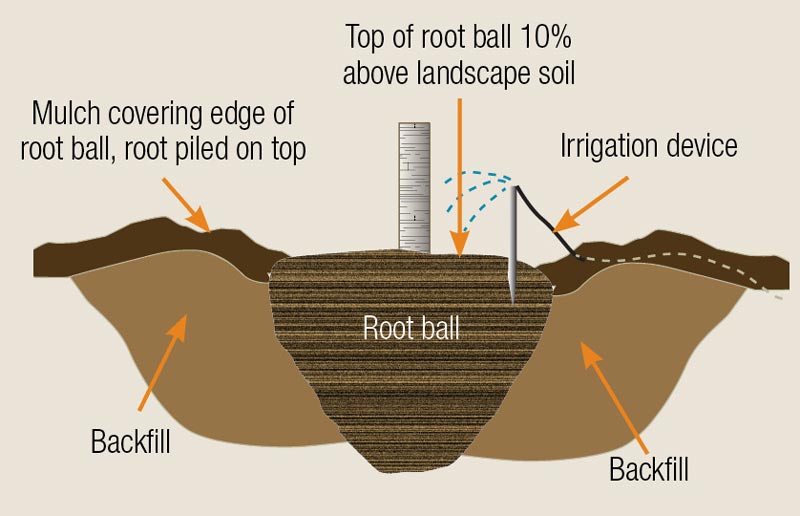
Ideally, all the constricted or encircled roots are able to be freed and spread laterally in the planting area. The other side of the spectrum is the need to cut through large roots to spread them out, an action that should be avoided to deter invasion of root decay organisms.
Another consideration in avoiding girdling roots is the matter of enhancing the planting area by adding sand, peat moss, bark, compost or other materials to encourage root growth. Unfortunately, in most cases, these amendments encourage the expanding roots to remain in the planting area instead of growing into undisturbed soil. The effect that is produced is similar to a perched water table. The soil that was removed to create the planting area is best to use as backfill for the new tree or shrub.
Just as soil amendments should be avoided, adding nutrients at planting time is usually counterproductive as well. Woody roots tend to be stunted as a result of coming into contact with fertilizer in the planting area. If the area is known to be of low fertility, it’s a good idea to test the soil to determine which nutrients (and in which form) should be added in later years.
Though it may seem obvious, constrictions such as burlap, pressed peat moss, string and cording should be removed from the root mass. The purpose of these materials is to keep the ball intact until arrival at the planting site. Unfortunately, all will increase the odds of restricting the expansion of the root system.
Unless the site is particularly wind-swept, staking is not necessary. The two most important guidelines for staking are to use a wide material to wrap around the trunk, and to attach the material loosely so that the trunk is allowed to sway lightly in the wind.
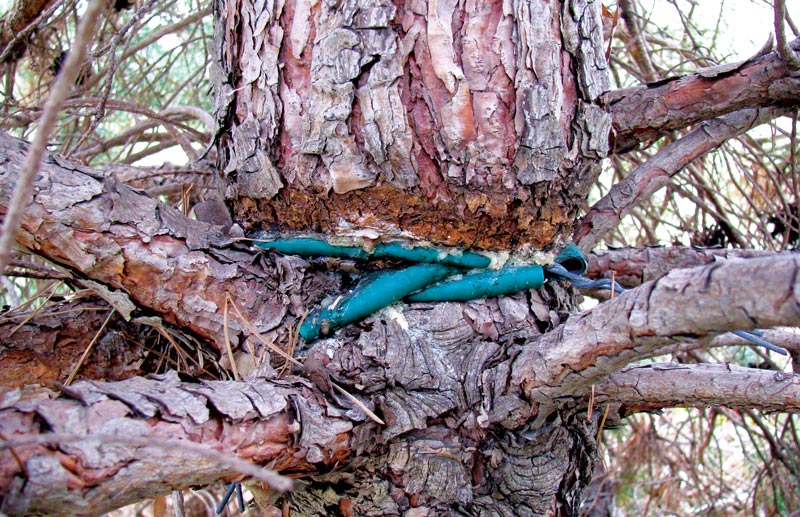
Narrow, wire-based materials are not appropriate for staking.
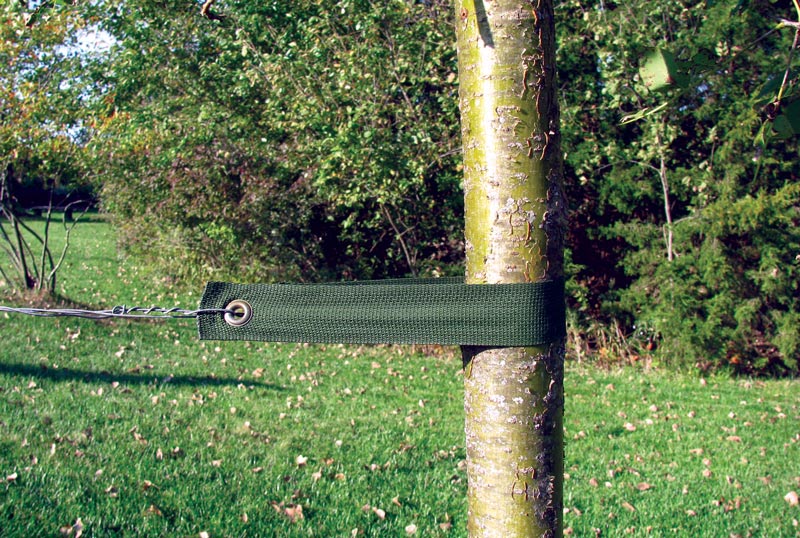
Staking isn’t always necessary. At wind-swept sites, wide pieces of fabric should be used for staking trees.
Proper staking — if needed at all — encourages good lateral root growth and decreases the likelihood that a tree will become dependent on the stake. Appropriate wrapping materials greatly reduce the chance of damage to the bark. Pieces of canvas, old T-shirts, bicycle inner tubes, pieces of drapery and recycled golf green flags work well to prevent damage.
Pruning prevention
After trees and shrubs have been established, small problems can be prevented from becoming larger ones by implementing sound pruning practices. Good pruning starts with the identification of suspect stems and branches. The ones that are most likely to cause a problem are rubbing and crossing, growing downward, are parallel to each other, and are arranged in a co-dominant fashion.
Removing one leader of a co-dominant stem in the first year of a tree’s life will prevent breakage and damage to the important targets underneath the tree — people and property. It will also initiate the compartmentalization process, isolating the wounded tissues from the rest.
If a co-dominant stem is not dealt with early in the tree’s life, removal after three to 10 years will expose sapwood, cambium and heartwood, significantly increasing the chances of decay intrusion. After decay has invaded the inner tissues, it’s irreversible. The overall principle for prevention is to remove a problem branch (the one with the smaller diameter) as soon as it is identified, which will allow for more rapid compartmentalization of the injury.
Though plant pathologists tend to disagree on the subject of decay prevention when pruning small limbs, using a disinfecting agent such as alcohol or bleach could prevent the transfer of certain diseases from one tree to the next. Generally, applying a 10 percent solution of either is a recommended practice.
Working with an arborist certified by the International Society of Arboriculture (ISA) is a wise preventive step as well. Taking advantage of an arborist’s years of training and experience is a great way to add capacity to the maintenance staff without adding the cost of operating equipment, and to transfer the liability of the pruning work to another party. In the event of a mishap, it’s their insurance that pays, not the course’s. Certified arborists for every locale can be found on the International Society of Arboriculture website.
Shrub plantings, especially older stands and hedges, benefit greatly from the removal of inner stems. For shrubs that develop canes — such as ninebark, lilac, forsythia, viburnum, spirea and dogwood — removing a third of the older stems each year will keep the plant young and thrifty, preventing borers and canker problems. If cane-growing shrubs have been neglected for many years and developed pests, “renewal pruning” is the best course of action. Use a chain saw to remove all stems at the ground level. If a healthy root system is in place, the shrub will produce new stems that are free of insects and diseases.
Biotic pest prevention
Pest control can be one of the costliest line items in the golf course maintenance budget. If the cost of controlling pests on the ornamentals were zero, all stakeholders would wear a big smile. Of course, that’s not realistic, but it’s certainly a worthy target. Three main categories of pests should draw the most attention.
Diseases
Disease resistance is a very effective method of pest prevention. With so many disease-resistant cultivars of crabapple, hawthorn, juniper, cherry, maple, etc., it’s simpler to head off disease at the pass by choosing plants with genetic resistance to fungi and bacteria. Other species, such as Russian olive and poplar, are quite susceptible to fungal diseases and should be avoided. In addition, forgo “trash” trees and shrubs such as tree of heaven and mulberry. Good sources of information on specific cultivars in each state include botanic gardens, arboretums and university Extension faculty.
Insects
Insects can also be controlled by selecting resistant species and cultivars. Certain tree and shrub species, such as ash, Scots pine and honeysuckle, are on the list of those to avoid.
Weeds
Prevention with mulch and pre-emergence herbicides pays dividends by greatly reducing the number of annual and perennial weeds that become established near ornamental plantings. The ones that escape control efforts are usually much easier to control by mechanical means or spot-spraying with Roundup. However, weed fabrics are not recommended, as they don’t offer a high degree of control and are expensive. It’s common to find weeds growing in the fabric itself, a result of soil and fallen leaf debris collecting in the fibers.
Abiotic pest prevention
In addition to pests that are caused by living organisms, agents and conditions that arise because of weather, vandalism or misunderstandings are worthy of attention as well.
Placing mulch around trees, shrubs, ground covers and perennials prevents mower blight. A 2- to 3-inch layer of natural wood-based mulch should be used, beginning several inches away from the trunk and extending as far into the golfscape as play will allow. Mulching will prevent fungal diseases such as armillaria root rot at the base of the trunk. The goal is to replicate what Mother Nature provides in a native setting.
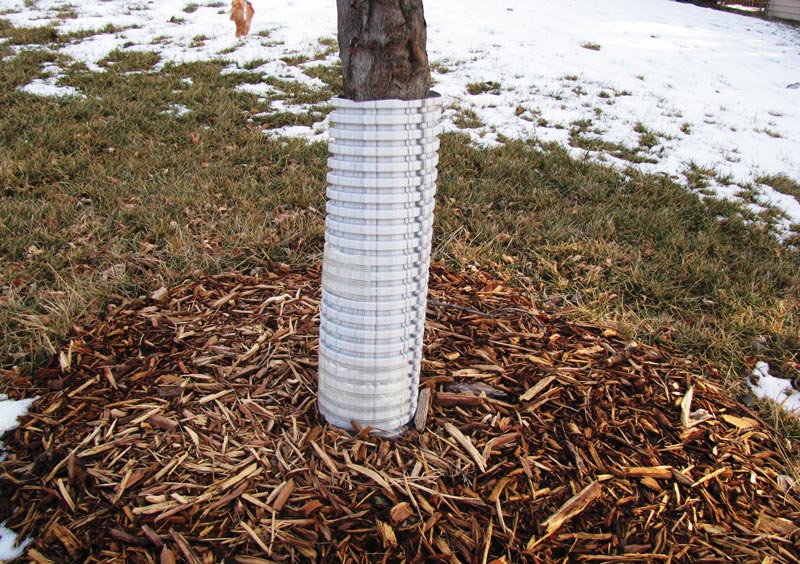
A collar will help prevent sunscald and rodent damage.
Installing protective devices around tree trunks or the thicker stems of multi-trunked shrubs will reduce the incidence of sunscald. Materials such as PVC form a protective collar against the sun’s harmful rays. During winter, the sun can overheat the tissues of thin-barked trees and cause a gradual sloughing and destruction of important cambial vessels. The collar should be white or beige to reflect the heat of the sun. A side benefit is the prevention of rodent injury.
Ice-melting products can cause serious injury to a variety of ornamentals. Especially where damage has been observed previously and in high-visibility locations, alternatives to sodium chloride should be considered, including a mix of sand and salt (instead of salt alone), calcium chloride and calcium magnesium acetate.
John C. Fech is a horticulturist and ISA-certified arborist with the University of Nebraska-Lincoln Extension. He is a frequent contributor to GCM.